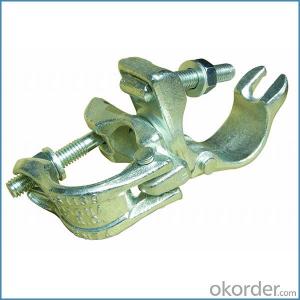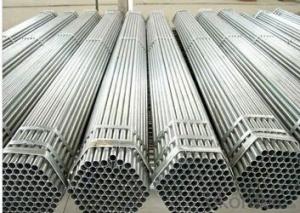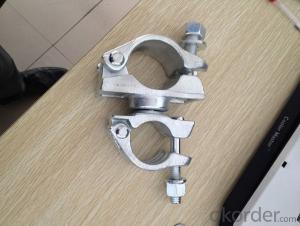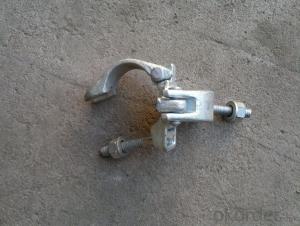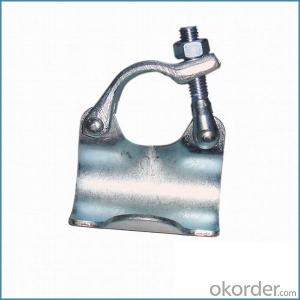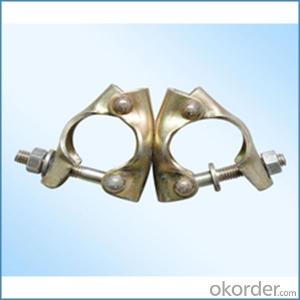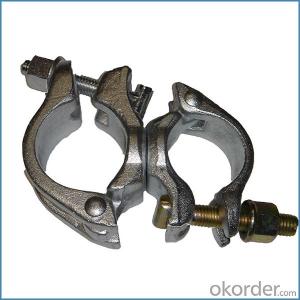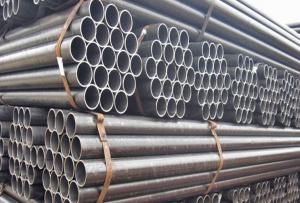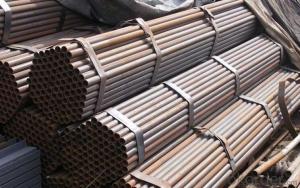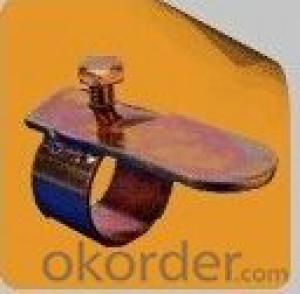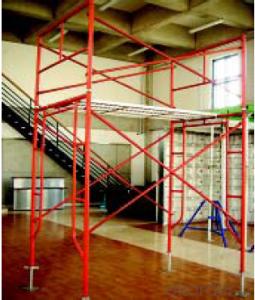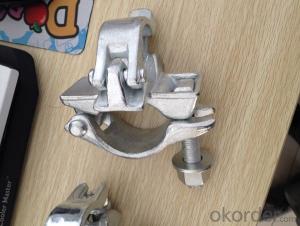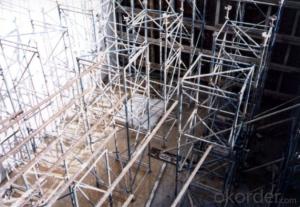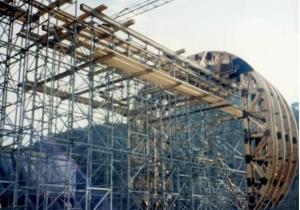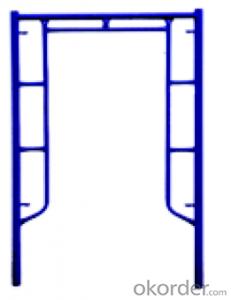Angle Coupler British Type for Sale in China
- Loading Port:
- Tianjin
- Payment Terms:
- TT OR LC
- Min Order Qty:
- 1000 kg
- Supply Capability:
- 100000 kg/month
OKorder Service Pledge
OKorder Financial Service
You Might Also Like
Scaffolding Half Swivel Coupler British Type
Description
1.The scaffolding coupler is always used to connect the steel pipe as scaffolding system.
2.The often used coupler is swivel coupler and righ angle coupler .
3.We can provide types of scaffolding coupler according to your requirement.
4.Couoler can fix the 48.3mm scaffolding steel pipe tightly and make the whole scaffolding system more steadily.
5.Material:Q235 steel
6.Overall Size:48.3mm*48.3mm
7.Surface Finish: Galvanized/ Painted
8.Standard:BS1139,EN74
9.Package:25pcs/bag
10.Manufactuering as per customer requirements
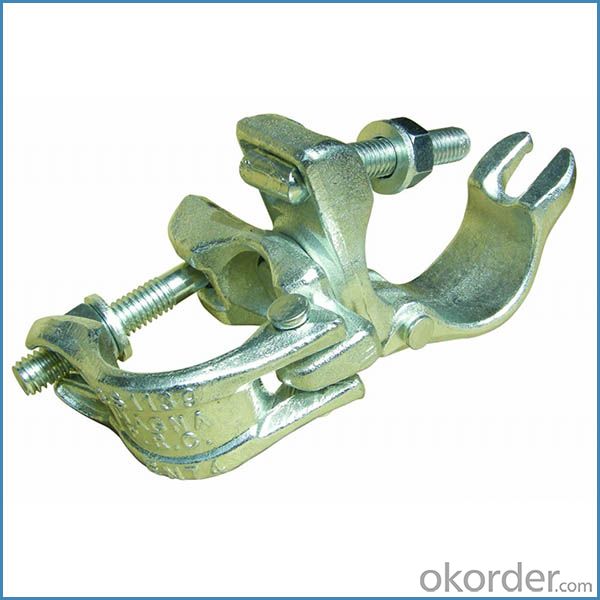
Feature
(1)Excellent Anti-Breaking—Cold Pressed Steel
(2)Outstanding Resistance Deformation
(3)Strong Anti-Dropping Ability
(4)Longtime USe
(5)Qualtity Guaranteed
(6)OEM Service
Photo
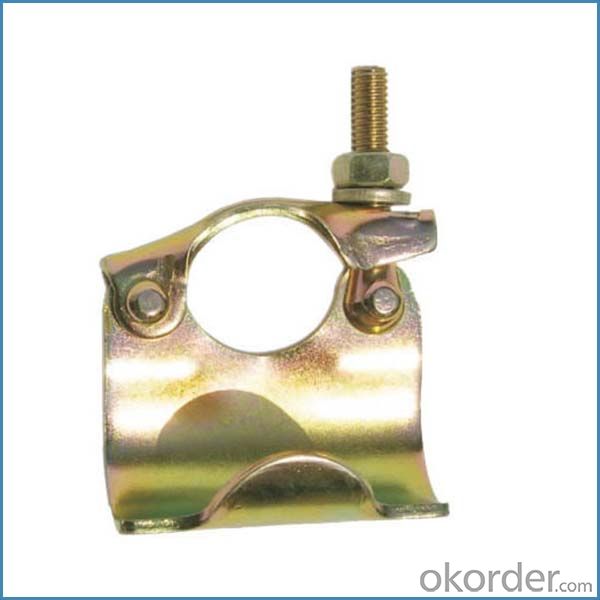
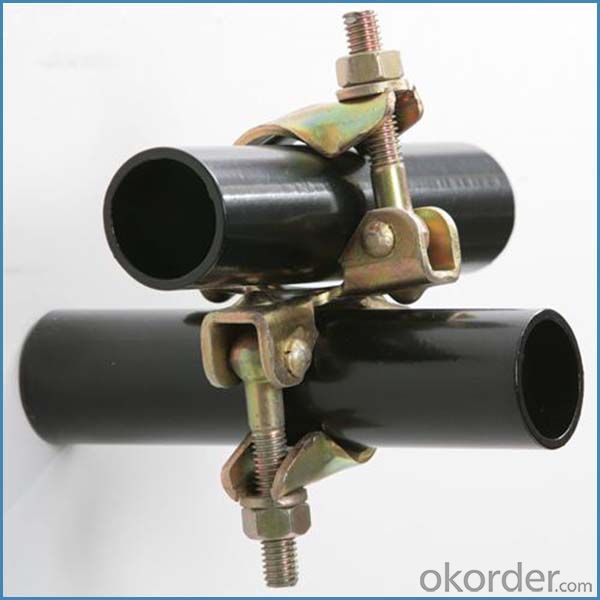
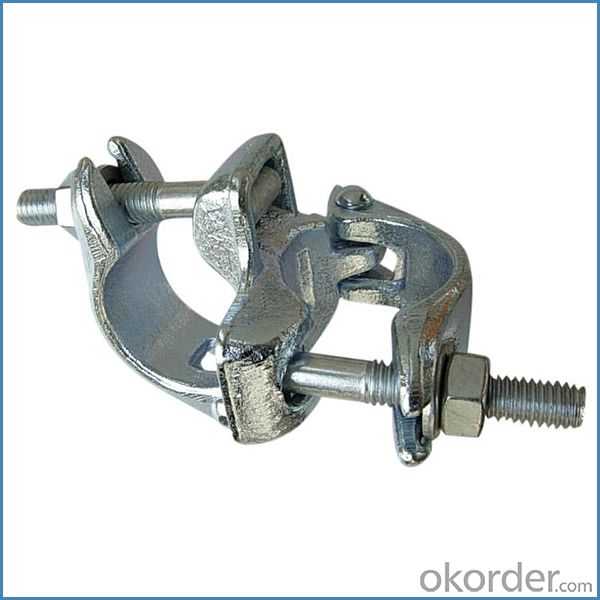
Parameter
| Material | Q235,345steel |
| Size | 48.3mm*48.3mm |
| Surface finish | Galvanized |
| Weight | 1.1kg around |
| Standard | BS1139,EN74 |
| Package | 25pcs/bag,steel pallet |
| Manufacture | As per customer requirement |
| Market | Africa, South America, the Middle East and Asia |
FAQ
Q: Are you a factory or trading company?
We are a state-owned corporation in China,dealing with various kinds of building materials.We have our holding subsidiaries.
Q: Where is your factory located? How can I visit there?
Our factory is located all around China.
Q: Can I get some samples?
Sample is free, customer only pay freight for the first time.
Q: Delivery?
10-30days. (5-15 containers)
Any question,feel free to contact us.
- Q:What are the requirements for inspecting steel tube couplers in scaffolding?
- The requirements for inspecting steel tube couplers in scaffolding include ensuring that they are properly installed and secure, free from any damage or corrosion, and in compliance with relevant safety standards and regulations. Regular inspection intervals should be established, and any faulty or defective couplers should be immediately replaced to maintain the integrity and safety of the scaffolding structure.
- Q:What are the typical installation methods for steel tube couplers in scaffolding?
- There are several typical installation methods for steel tube couplers in scaffolding. One common method is the sleeve coupler installation. This involves sliding the sleeve coupler onto the end of a scaffold tube, ensuring it is positioned correctly and aligning the holes on both the coupler and the tube. Once aligned, a steel bolt is inserted through the holes and tightened using a wrench, creating a secure connection between the tube and the coupler. Another method is the swivel coupler installation. Swivel couplers are used to connect two scaffold tubes at any angle, making them highly versatile. To install a swivel coupler, the coupler is placed between the two tubes, ensuring that the holes on all three components align. A steel bolt is then inserted through the aligned holes and tightened using a wrench, creating a strong connection that allows for rotation and adjustment. Additionally, there is the putlog coupler installation method. Putlog couplers are used to connect scaffold tubes to walls or other structures. To install a putlog coupler, the coupler is positioned against the structure, and the putlog tube is inserted into the coupler. A steel bolt is then inserted through the holes on the coupler and tightened, securing the putlog tube in place. Lastly, the girder coupler installation method is used to connect scaffold tubes to steel beams or girders. This involves placing the girder coupler onto the beam or girder, ensuring the holes on both components align. A steel bolt is then inserted through the aligned holes and tightened, creating a secure connection. Overall, these installation methods for steel tube couplers in scaffolding provide reliable and sturdy connections, allowing for safe and efficient construction activities.
- Q:How do you inspect steel tube couplers for any signs of damage or wear?
- Inspecting steel tube couplers for signs of damage or wear is essential to ensure their structural integrity and prevent potential accidents or failures. Here are some steps to follow in order to effectively inspect steel tube couplers: 1. Visual Inspection: Begin by visually examining the coupler for any obvious signs of damage or wear. Look for cracks, dents, corrosion, or any other visible abnormalities. Pay attention to the surface condition, edges, and welds. 2. Cleanliness: Before proceeding with a more detailed inspection, ensure that the coupler is thoroughly cleaned. Remove any dirt, debris, or coatings that may obstruct your view of potential damage. 3. Magnifying Tools: Utilize magnifying tools such as a magnifying glass or microscope to closely examine the coupler's surface. This will help identify small cracks, pitting, or other signs of wear that may be difficult to see with the naked eye. 4. Non-Destructive Testing: Consider employing non-destructive testing techniques such as ultrasonic or magnetic particle testing. These methods can detect hidden defects and cracks that may not be visible from the surface. 5. Dimensional Inspection: Verify that the coupler's dimensions conform to the required specifications. Measure the inner and outer diameters, thickness, and length to ensure they align with the manufacturer's guidelines. 6. Load Testing: If necessary, subject the coupler to load testing to assess its strength and structural integrity. This can be done by applying a predetermined load and monitoring for any signs of deformation or failure. 7. Documentation: Document all findings and observations during the inspection process. This will help track any changes or trends over time and aid in making informed decisions regarding maintenance or replacement. 8. Regular Inspections: It is recommended to conduct periodic inspections of steel tube couplers, especially in high-stress applications or environments. Regularly check for signs of wear, corrosion, or any other potential issues to ensure the couplers remain in optimal condition. By following these steps, you can effectively inspect steel tube couplers and identify any signs of damage or wear. Regular inspections and maintenance will help ensure the safety and longevity of the couplers, minimizing the risk of failures or accidents.
- Q:How do steel tube couplers affect the overall stability and sturdiness of scaffolding towers?
- Steel tube couplers play a crucial role in enhancing the overall stability and sturdiness of scaffolding towers. These couplers are used to connect different tubes and components, ensuring a secure and rigid structure. By effectively distributing the load and providing a tight connection, steel tube couplers prevent any movement or shifting of the scaffolding, which helps maintain its stability and structural integrity. Additionally, their robust construction and reliable grip ensure that the scaffolding tower remains sturdy and can withstand heavy loads and external forces, making them essential for safe and reliable construction projects.
- Q:Are steel tube couplers resistant to bending or deformation under heavy loads?
- Steel tube couplers are designed to be extremely strong and resistant to bending or deformation under heavy loads. These couplers are typically made from high-strength steel and are engineered to withstand the forces exerted on them during use. The steel used in these couplers is chosen for its ability to handle heavy loads without bending or deforming. Additionally, steel tube couplers undergo rigorous testing and quality control measures to ensure their strength and durability. They are subjected to various load tests to determine their maximum load capacity and resistance to bending or deformation. These tests simulate real-world conditions and ensure that the couplers can withstand the heavy loads they are intended to bear. Furthermore, steel tube couplers are often used in construction and other industries where heavy loads are common. They are chosen for their ability to provide a strong and reliable connection between two steel tubes or pipes. The design and construction of these couplers are specifically engineered to resist bending or deformation under heavy loads, making them a trusted choice for applications where strength and durability are paramount. In conclusion, steel tube couplers are indeed resistant to bending or deformation under heavy loads. Their design, construction, and material composition make them highly durable and capable of handling the forces exerted on them. These couplers are a reliable choice for applications where heavy loads are expected, ensuring a secure and stable connection between steel tubes or pipes.
- Q:How do steel tube couplers help in connecting scaffold tubes?
- The connection of scaffold tubes is facilitated by the use of steel tube couplers, which provide a secure and dependable link between the tubes. These couplers are specially designed to join two scaffold tubes together, enabling the construction of a stable and robust scaffold structure. One of the primary benefits of utilizing steel tube couplers is their ability to offer a rapid and efficient means of connecting scaffold tubes. These couplers are user-friendly and require minimal effort to install, thereby expediting the assembly process of the scaffold and enhancing its efficiency. Furthermore, steel tube couplers possess a high level of strength and durability. Crafted from superior-quality steel, they can withstand substantial loads and create a safe working environment for construction workers. The couplers are engineered to prevent any movement or slippage between the tubes, thereby ensuring the scaffold structure remains stable and secure. In addition, steel tube couplers provide versatility in connecting scaffold tubes. They are available in various sizes and configurations, enabling the connection of tubes with different diameters and angles. This adaptability ensures that the scaffold structure can be customized to meet the specific requirements of the construction project. In conclusion, steel tube couplers play a vital role in connecting scaffold tubes by offering a swift, robust, and flexible assembly method. They establish a dependable connection that guarantees the stability and safety of the scaffold structure, making them an indispensable component in the construction industry.
- Q:What are the recommended safety precautions for using steel tube couplers in scaffolding?
- The recommended safety precautions for using steel tube couplers in scaffolding include ensuring proper installation by trained personnel, regularly inspecting the couplers for any signs of damage or wear, using compatible couplers from the same manufacturer, avoiding overloading or excessive stresses on the couplers, and following all relevant safety guidelines and regulations. It is also important to provide adequate training and supervision to workers using scaffolding with steel tube couplers to minimize the risk of accidents or injuries.
- Q:Can steel tube couplers be used in scaffolding systems that need to support specialized equipment or machinery for industrial applications?
- Yes, steel tube couplers can be used in scaffolding systems for industrial applications that require support for specialized equipment or machinery. Steel tube couplers are designed to provide secure connections between scaffolding tubes, ensuring stability and strength. They are capable of withstanding heavy loads and are commonly used in industrial scaffolding projects.
- Q:What are the load capacities of different types of steel tube couplers?
- The load capacities of different types of steel tube couplers vary depending on factors such as their size, design, and material strength. It is best to consult the manufacturer's specifications or industry standards to determine the specific load capacities for each type of steel tube coupler.
- Q:what is scaffold in tissue engineering?
- it's the structure that the tissue attaches or grows on. This scaffold supports the tissue and causes the shape. An ear would be an example of scaffolding by allowing an implantable framework to be placed under the skin on the back of a rat. Tissue will then grow and attach.
1. Manufacturer Overview |
|
|---|---|
| Location | |
| Year Established | |
| Annual Output Value | |
| Main Markets | |
| Company Certifications | |
2. Manufacturer Certificates |
|
|---|---|
| a) Certification Name | |
| Range | |
| Reference | |
| Validity Period | |
3. Manufacturer Capability |
|
|---|---|
| a)Trade Capacity | |
| Nearest Port | |
| Export Percentage | |
| No.of Employees in Trade Department | |
| Language Spoken: | |
| b)Factory Information | |
| Factory Size: | |
| No. of Production Lines | |
| Contract Manufacturing | |
| Product Price Range | |
Send your message to us
Angle Coupler British Type for Sale in China
- Loading Port:
- Tianjin
- Payment Terms:
- TT OR LC
- Min Order Qty:
- 1000 kg
- Supply Capability:
- 100000 kg/month
OKorder Service Pledge
OKorder Financial Service
Similar products
New products
Hot products
